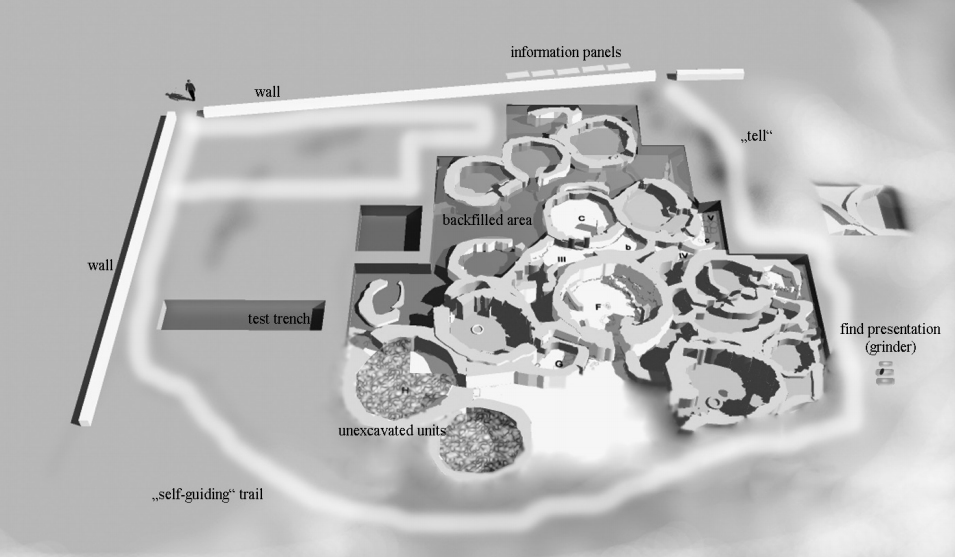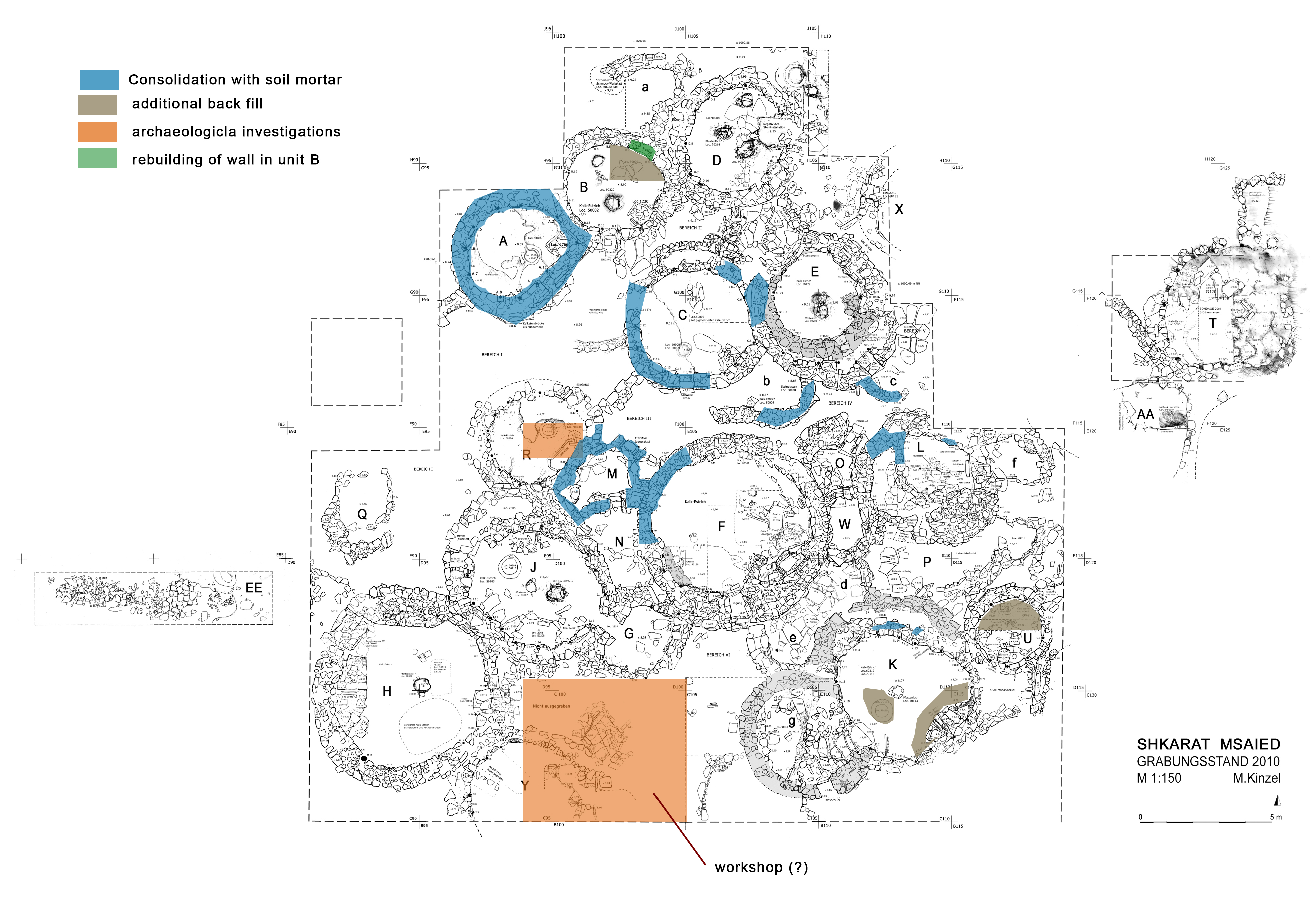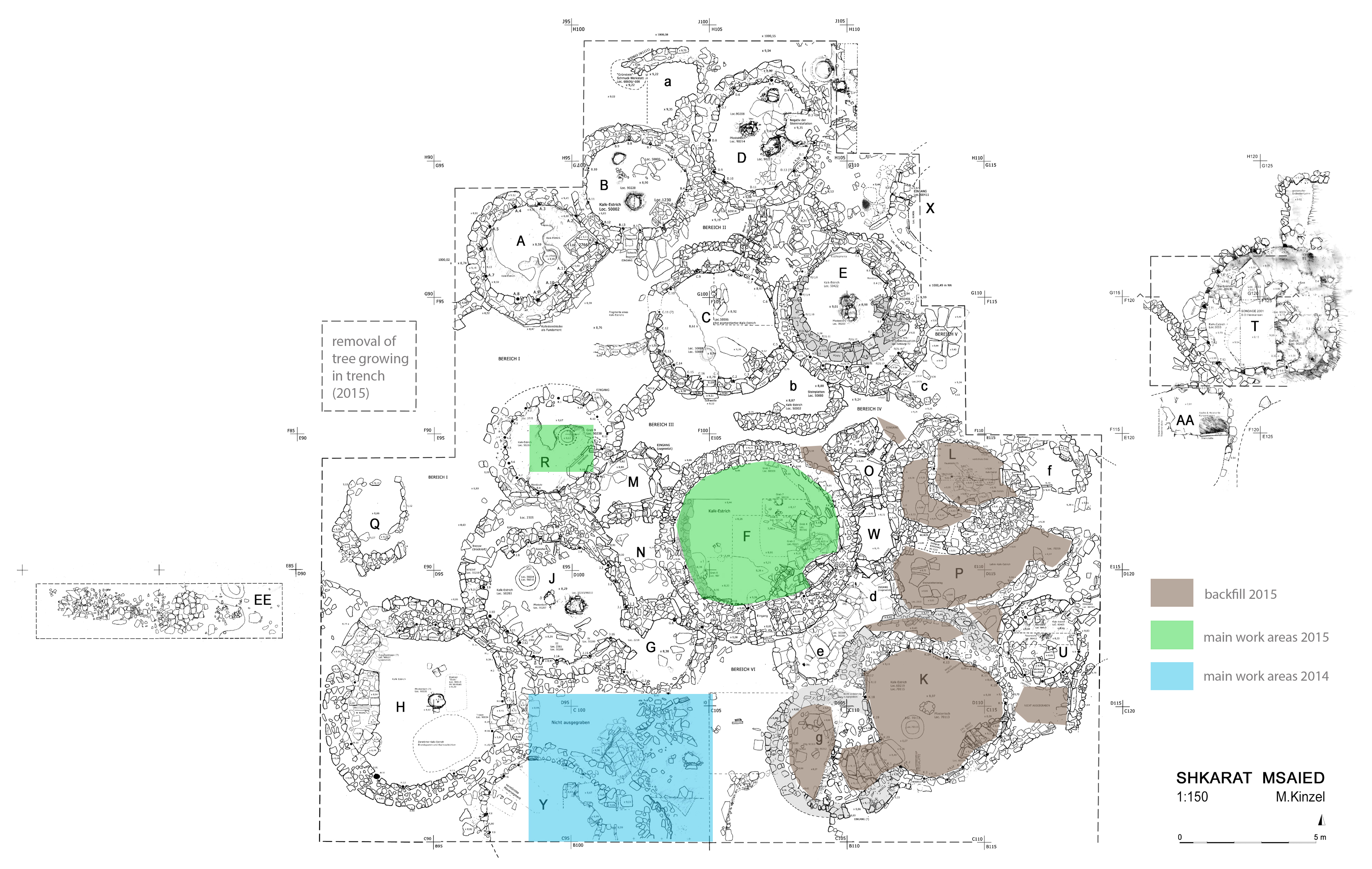Protection, Conservation, and Site Management at Neolithic Shkarat Msaied

SM2015 Backfilling of Unit K
Over the years a series of conservation and preventive preservation measures were carried out to protect the fragile archaeological remains at Shkarat Msaied. We are following a low impact strategy of minor stabilization works and major backfilling.
For the consolidation a simple soil/mud mortar is used, made of material from the site, actually from the excavation spoil heaps. In addition to the sieved spoil heap soil the Petra Department has provided some sterile Wadi sand of local origin for the major backfill activities.
Two sets of walls are protecting the excavation trench against the impact of surface run-off water, while a self-guiding track keeps visitors out of the actual trenches and invites to a nice tour around it with good insights into the site.
Further backfilling and stabilization works are planned in the coming seasons.

SM2010 Mapping of backfill (sterile Wadi sand)
2010 (from End of Season Report to the Department of Antiquities)
Preservation and conservation
[...] Another purpose of this season was to backfill most parts of the site to avoid further damages to the archaeological remains. According to the general guidelines for the preservation and presentation of sites within the framework of the Neolithic Heritage Trail, to whom also Shkārat Msaied belongs, it was decided to keep some of the structures without backfill (Finlayson et al.2007; Kinzel 2008). The wall tops and upper wall parts are still visible and will still give a quite impressive picture of the site to visitors (see fig. 13).
The material used to backfill the buildings is of fine grained, sterile sand from the Wadi reminiscent to the site. The sand and its transportation was organized and conducted by the Petra Development & Tourism Region Authorities - Petra Archaeological Park & Cultural Heritage Department (Thanks to our Representative Talal Hamid al-Ammarin).
Before backfilling building documentation – photographing, drafting etc. – was conducted. Moreover minor conservation operations were undertaken especially of collapsed door demarcation stones and tumbled wall stones. These were repositioned and fixed by using simple soil / mud-mortar as bonding agent (Fig. 14). Also some voids in wall structures and open joints were filled with the same soil mortar. The mortar was produced with sieved soil form the excavation dump, Wadi sand and water. The mortar should only stabilize the structures as long as the final backfill is not finished. The interior wall faces and the preserved parts of the plaster floors were covered with Hessian (fig. 15). Sand was then added both inside the buildings and outside in order to prevent fragile walls from further damage. For the presentation of the larger houses in the southern part of the site different concepts for presentation and preservation were discussed with the Petra Archaeological Park & Cultural Heritage Department. A final decision still await, however the buildings which bear a high risk of being further damaged, e.g. Unit K, were partly backfilled. For the presentation of the Neolithic Period in the Petra-Region in the new visitor centre a 3d-scan of building F, H, J and K should be taken in to consideration in the nearest future.
Moreover, the development of a virtual model of the site and an animated reconstruction could fit into the visitor centre concept and the planned open source data base of the Shkārat Msaied Project. The measurements taken (cleaning, backfill, consolidation, access regulation/fencing, and guiding) during this season of excavation should be seen as an initial investigation for site preservation and presentation in Shkārat Msaied. Cooperation between the responsible local authorities and the Shkārat Msaied Heritage Project of the University of Copenhagen was discussed for the development of a final site preservation programme and site presentation concept. Shkārat Msaied should be presented in the frame work of the other Neolithic sites in the Petra-Region. For the near future it is planned to place an info panel in English and Arabic on site as an initial initiative for the so called “Neolithic Heritage Trail”.[...]

SM Site management plan (after Kinzel 2008:Fig.5)

SM2014 Plan of the site with areas of consolidation, backfill and excavation work
2014 (from End of the season report to the Department of Antiquities)
[...] In addition to the above presented archaeological investigations the state of conservation of each building unit was assessed and documented (see App.1 State of Conservation report, attached). In general the site is in relatively good condition. The fence around the site is in good conditions, but would require in the future a proper gate/door to allow access.
Most damaged seems to be related to the intense rainfall in winter 2013/2014, but also vandalism. On the other hand also the exposure of the remains to weathering, including intense sun and wind, has resulted in the loss of bonding of the historic Neolithic wall mortars as well as the disintegration of the (sand-) stone
material itself. Especially the sand stone slabs showing flaking and detachment of layers, etc.
However the backfill executed in 2010 seems to fulfil its purpose to stabilize the structures. The surface run-off water in relation to the heavy winter rainfall has created some drainage gullies in the backfill material. In some cases (Unit J, K, P) single wall segments between the post channels (sockets) are collapsed due to the loss of bonding and rainwater penetrating the wall core.
To reduce the risk of wall collapse some stabilization and consolidation works were executed. In Unit A, C, E, F, K, L, and M joints were re-pointed and voids filled using a (simple) soil mortar. This mortar is made out of the sieved spoil heap soil and water. Due to the high content of calcite (lime) in the soil the mortar is relatively stable but softer than the stone material and the Neolithic mortars containing partly burned lime.
The same mortar was used to complete some wall capping to prevent water penetrating the wall core. The mortar has to be seen as a sacrificial layer. Regular monitoring will help to define maintenance cycles necessary to maintain the current state.
In addition to the consolidation also some backfill was carried out in a few areas to prevent collapse respectively water penetration. To improve the appearance of the site and also to protect the remains all building units were cleaned off of plants and litter (Fig.6).

SM2014/2015 Areas of backfill and other works
2015 (from End of the season report to the Department of Antiquities)
State of conservation, protective measures and recommendations
In general the site is in a good condition. The fence around the site fulfils its purpose, but would require in the future a proper gate/door to allow a better access. In addition to the above presented archaeological investigations the state of conservation of the site in general and some units was assessed and documented.
Compared to the number of damages reported in 2013/2014 only little actual damages can be seen in 2015. Most damaged seems to be related to the intense rainfall in winter 2013/2014, but also vandalism. On the other hand also the exposure of the remains to weathering, including intense sun and wind, has resulted in the loss of bonding of the historic Neolithic wall mortars as well as the disintegration of the (sand-) stone material itself. Especially some of the sand stone slabs showing flaking and detachment of layers, etc. The soil mortar used for the consolidation of some walls in 2014 seems to be efficient, but will need some maintenance works in the coming year. We plan to seek additional funding for conservation measures and site presentation measures. The self-guiding track around the excavation area has proven to be very good way of keeping visitors out of the actual trench. Additional info panels could add considerably to the understanding of the site, but also more innovative techniques as mobile apps could work fine to explain the various features and could actually provide AR-3D-reconstructions of the buildings. The concept of the Neolithic Heritage trail should be followed more straight forward. Perhaps an Info-Centre for the Neolithic of the Greater Petra Area could help in presenting the sites to a wider public.
Backfill seems to be the most efficient protection of the fragile remains. The backfill executed in 2010 and late 2014 fulfil its purpose to stabilize the structures. To reduce the risk of wall collapse some stabilization and consolidation works were executed also in this year. In Units L, P and K intense backfilling was carried out to prevent collapse respectively water penetration. In Unit F and R only limited areas were backfilled to allow an easy continuation of work again in 2016.
To improve the appearance of the site and also to protect the remains all building units were cleaned off of plants and litter. We have also had the juniper tree cut down which was growing since some time in our trench F90. This should be repeated annually to prevent further damages by the roots of the vegetation. This could actually be carried out by the site guard.
We are happy to work out and to discuss a proposal for the future presentation of the site and the Neolithic period in general with the Department of Antiquities as well as with the Petra Archaeological Park Authorities.
We plan to return in 2016 for further archaeological investigations in unit F and R to continue the works there to gather the necessary materials and information for a monograph. A publication project is planned to take place after the burials in unit F are fully investigated. Parallel to the archaeological investigation comprehensive conservation works should take place and the above mentioned presentation concept be designed and implemented.

SM2016 Areas of work and backfill
2016 (from End of the season report to the Department of Antiquities)
State of conservation, protective measures and recommendations
In general the site is in relatively good condition. The fence around the site is in fair conditions. Some post could require a replacement and it should be considered to actually provide an actual gate/door to allow better access to the site.
Most damaged seems to be related to the intense rainfall in winter. On the other hand also the exposure of the remains to weathering, including intense sun and wind, has resulted in the loss of bonding of the historic Neolithic wall mortars as well as the disintegration of the (sand-) stone material itself. Especially some of the sand stone slabs showing flaking and detachment of layers or complete disintegration of the sandstone components. Vandalism was not observed this year.
However, the backfill seems to fulfil its purpose to stabilize the structures and to prevent major damages to the buildings. To reduce the risk of wall collapse some stabilization and consolidation works were executed. Various spots on site were chosen for backfill to prevent collapse respectively water penetration. Measures were applied this year in units D, E, J, K, L and in Areas II and III as well as enclosure c. Structures were filled with fist-sized stones and an additional layer of sieved soil form the spoil heaps. To improve the appearance of the site and also to protect the remains all building units were cleaned off of plants and litter. Annually the vegetation on site should be removed to prevent further damages by the roots.
References
Kinzel, M. 2008. Preservation and presentation of Neolithic sites: A case study at Shkarat Msaied, Southern Jordan. In Marchetti, N & Thuesen I. (eds.) ARCHAIA Case studies on research planning, characterisation, conservation and management of archaeological sites. Bar Int. Ser. 1877: 331-340
For further enquiries please contact Moritz Kinzel.

SM2014 Consolidation of Neolithic wall with soil mortar (Unit M)

